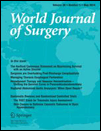A Simple Risk Score to Predict the Presence of Non-Sentinel Lymph Node Metastases in Breast Cancer Patients with a Positive Sentinel Node
Abstract
Background
Historically, completion axillary lymph node dissection (cALND) is recommended in sentinel lymph node (SLN)-positive patients. However, the high rate of negative non-sentinel nodes (NSNs) in cALND and the reported low axillary recurrence rates have led to a more conservative approach. A risk score was developed to identify a patient’s individual risk for NSN metastases.
Methods
Data of 182 SLN-positive patients who underwent cALND were used for risk score development. The risk score, consisting of pathological tumor size (≤20/>20 mm), lymphovascular invasion (no/yes), extracapsular extension (no/yes), size of metastases (≤2/>2 mm), and number of positive SLNs (1/>1), was subsequently validated on an external population (n = 180).
Results
The area under the receiver operating characteristic curve was 0.78 (95 % CI 0.71–0.85) in the original population and 0.78 (95 % CI 0.70–0.85) in the validation population. Based on the predicted risk for positive NSNs, three groups were defined: low risk (≤20 %), intermediate risk (21–50 %), and high risk (>50 %). In total, 88 patients met the Z0011 inclusion criteria and none of them had a high predicted risk. Of the 199 non-Z0011 patients, 67 (33.7 %) had low risk, 96 (48.2 %) had intermediate risk, and 36 (18.1 %) had high risk.
Conclusion
A simple risk score, integrating just five clinicopathological variables, was developed that may assist in individual decision making regarding ALND in SLN-positive patients outside of the Z0011 trial.




